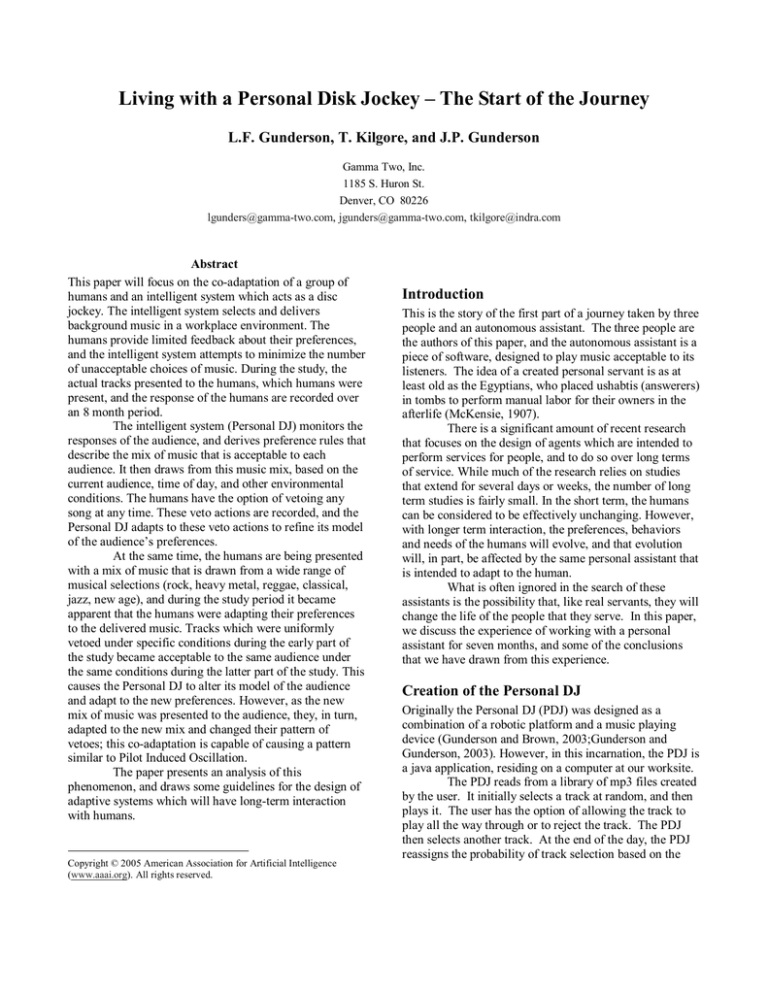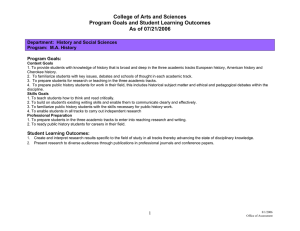
Living with a Personal Disk Jockey – The Start of the Journey
L.F. Gunderson, T. Kilgore, and J.P. Gunderson
Gamma Two, Inc.
1185 S. Huron St.
Denver, CO 80226
lgunders@gamma-two.com, jgunders@gamma-two.com, tkilgore@indra.com
Abstract−
This paper will focus on the co-adaptation of a group of
humans and an intelligent system which acts as a disc
jockey. The intelligent system selects and delivers
background music in a workplace environment. The
humans provide limited feedback about their preferences,
and the intelligent system attempts to minimize the number
of unacceptable choices of music. During the study, the
actual tracks presented to the humans, which humans were
present, and the response of the humans are recorded over
an 8 month period.
The intelligent system (Personal DJ) monitors the
responses of the audience, and derives preference rules that
describe the mix of music that is acceptable to each
audience. It then draws from this music mix, based on the
current audience, time of day, and other environmental
conditions. The humans have the option of vetoing any
song at any time. These veto actions are recorded, and the
Personal DJ adapts to these veto actions to refine its model
of the audience’s preferences.
At the same time, the humans are being presented
with a mix of music that is drawn from a wide range of
musical selections (rock, heavy metal, reggae, classical,
jazz, new age), and during the study period it became
apparent that the humans were adapting their preferences
to the delivered music. Tracks which were uniformly
vetoed under specific conditions during the early part of
the study became acceptable to the same audience under
the same conditions during the latter part of the study. This
causes the Personal DJ to alter its model of the audience
and adapt to the new preferences. However, as the new
mix of music was presented to the audience, they, in turn,
adapted to the new mix and changed their pattern of
vetoes; this co-adaptation is capable of causing a pattern
similar to Pilot Induced Oscillation.
The paper presents an analysis of this
phenomenon, and draws some guidelines for the design of
adaptive systems which will have long-term interaction
with humans.
Copyright © 2005 American Association for Artificial Intelligence
(www.aaai.org). All rights reserved.
Introduction
This is the story of the first part of a journey taken by three
people and an autonomous assistant. The three people are
the authors of this paper, and the autonomous assistant is a
piece of software, designed to play music acceptable to its
listeners. The idea of a created personal servant is as at
least old as the Egyptians, who placed ushabtis (answerers)
in tombs to perform manual labor for their owners in the
afterlife (McKensie, 1907).
There is a significant amount of recent research
that focuses on the design of agents which are intended to
perform services for people, and to do so over long terms
of service. While much of the research relies on studies
that extend for several days or weeks, the number of long
term studies is fairly small. In the short term, the humans
can be considered to be effectively unchanging. However,
with longer term interaction, the preferences, behaviors
and needs of the humans will evolve, and that evolution
will, in part, be affected by the same personal assistant that
is intended to adapt to the human.
What is often ignored in the search of these
assistants is the possibility that, like real servants, they will
change the life of the people that they serve. In this paper,
we discuss the experience of working with a personal
assistant for seven months, and some of the conclusions
that we have drawn from this experience.
Creation of the Personal DJ
Originally the Personal DJ (PDJ) was designed as a
combination of a robotic platform and a music playing
device (Gunderson and Brown, 2003;Gunderson and
Gunderson, 2003). However, in this incarnation, the PDJ is
a java application, residing on a computer at our worksite.
The PDJ reads from a library of mp3 files created
by the user. It initially selects a track at random, and then
plays it. The user has the option of allowing the track to
play all the way through or to reject the track. The PDJ
then selects another track. At the end of the day, the PDJ
reassigns the probability of track selection based on the
rejection rate of the user. The interface is very simple and
is shown below.
Figure 1: Screen shot of the Personal DJ Interface.
Software Control
The personal DJ has a very sparse interface. The only
control that the user has is to turn it on (Start), reject the
current track (No), and quit the system (Exit). In addition,
as the audience changes (e.g., new listeners arrive, or
current listeners leave the area) the current listener set can
be adjusted.
Normal Operations
Upon startup, the Personal DJ loads a music catalog, which
includes a listing of every mp3 in the current library. Each
track has information which includes the path to find the
file, the total number of times that the track has been
started (attempts) and the number of times that the track
has played to completion. In addition, there is information
that indicates that a track is part of a sequence of tracks
that should be played in sequence.
This later information was added to support a
number of classical selections that had complete works
(symphonies, operas) spanning multiple tracks on the CD.
It was found that having an aria cut-off in mid note, and be
followed with a completely different type of music was
disturbing. The users can encode two types of sequential
information into the music catalog, either only play this as
part of the complete sequence, or play it individually as
well as part of the complete sequence.
Once the music catalog has been loaded, a second
pass is made to detect newer music that has not been
played sufficiently to establish a base acceptance rate. This
component was added late in the testing when it became
apparent that after five to six months of running, almost
one quarter (22.6%) of the tracks had never been played.
At this point the DJ has two catalogs to draw from: the
complete listing of every track in the library, and a fifty
song short list of tracks that have not been played
sufficiently.
When the user presses the Start button, the DJ
enters the normal play mode. It first selects which playlist
to draw from, using a pseudo-random number generator
with a 50/50 chance of either list being selected. Once the
list is chosen, a selection process begins. First a track is
selected at random (uniform distribution across all tracks)
and then a decision is made by generating another random
number in the range [0..1). If the value of the selection
variable is less than the tracks base rate of acceptance, the
track is selected for play. However, if not: a new track is
drawn from the same playlist, and the process repeats until
a track is selected. If the track was drawn from the
shortlist, the track is removed from the shortlist to prevent
multiple plays of the same track too close together (See the
Observations section below).
The only alteration to the random selection
process is in the case of a sequence of linked tracks. This
has two impacts on song selection. First, if the randomly
selected track is part of a sequence, and not the first track
in the sequence it is rejected immediately. Second, if the
track that just completed playing has a successor track, the
successor is played without any random selection being
made. Thus, if we begin playing Beethoven’s ninth
symphony, it will play to completion, rather than switching
to Dire Straits (for example) part way through the first
movement.
Once the system has determined the next track to
be played, the track is passed to an MP3 player engine
which marshals the audio data and passes it to the
computers audio system. While the track is being played,
control returns to the DJ interface, which monitors for
further user input.
User Input
From the interface shown in Figure 1, it is clear that the
user does not have a lot of options for further input to the
system. Other than editing the current listener list, all the
users can to is either shut the system down, or press the No
button. If this button is clicked, the DJ immediately
terminates the current play, and records an entry into the
event log. This entry includes when the track began
playing, the list of current listeners, and the when the track
was rejected. All times are recorded to the nearest second.
Edit Audience
Whenever a change is made to the current listener list, an
entry is made in the log file indicating which listener was
added or dropped, the time, and the currently playing
track. At present this information is not used; however see
the notes in the future work section, and the description in
Gunderson and Gunderson, 2003.
Adaptation
900
800
700
600
500
400
300
200
100
(1)
The results of the rate update are written out in the revised
music catalog. And the DJ will load it on the next startup,
where it will control the song selection process. It is clear
from this process that the rate of adaptation shown by the
Personal DJ is fairly slow. This has profound impacts on
the testing process. The length of the test is further
impacted by the real-time nature of the testing. The
personal DJ is running in the lab for approximately 6 to 10
hours each day. While this seems on the surface to be a lot
of time, it is only enough time to allow between 150 and
200 tracks to play to completion a day. Given the realities
of live testing, the actual average number of tracks played
per day in closer to 80.5. As a result, we are only
collecting about 1600 datapoints per month. When this is
coupled with the large number of tracks in the catalog, and
the qualities of random probing, we found that even after
eight months of testing a large percentage of the tracks had
been played too little for the DJ to have a significant
estimator of the acceptance rate.
At the time of this writing, the distribution of the
attempt counts for the complete catalog is shown in the
figure below:
15
More
14
13
12
11
9
10
8
7
6
5
4
3
2
1
0
0
The key method for adaptation is revising the base rate
acceptance of each individual track. At a fixed time each
day, a second software component is triggered which loads
the music catalog and the daily event log. Each entry in the
event log is examined, and the corresponding information
in the play list is updated. In the case of a track which has
been completed, both the number of attempts and the
number of successful completions are incremented by one.
In the case of a track that is rejected, only the attempt
count is incremented.
As a result, the DJ can calculate the base
acceptance rate of any track, by:
Acceptance = successes / attempts
Histogram of Playlist
Number of Songs
System Shutdown
Upon system shutdown, a final log entry is made to the
file, which includes the time stamp, what track was
playing, the current listener list, and the shutdown flag.
The event file is maintained in a append mode, so that if
the DJ is shutdown in the middle of the day, and restarted,
it continues adding to the daily logfile, without any loss of
data.
Time s Played
Figure 2: Histogram of number of times a track has
been played, after eight months of testing.
From the data presented in Figure 2, it is clear that the
majority of the tracks have been played less that three
times during the course of the study. As a result, the DJ
does not have an accurate estimator for over half the
tracks. In effect, almost half the time, it is selecting tracks
with no data to determine if they meet the preferences of
the listeners.
Testing of the Personal DJ
Originally, we felt that we could use a traditional metric,
such as rejection rate, to measure the success of the PDJ.
However, this metric is a proxy for the real metric, which
is the subjective experience of the listener. Measuring the
response rate, while interesting, is like loosing your wallet
in Central Park, but looking for it in Times Square because
the light was better there. However, this changes the study
from the type of statistical study that is generally done in
the physical sciences and engineering, to the type of
observational study that is done in anthropology, sociology
and psychology.
In light of this, we both collected data on
rejection rates and the user’s subjective responses to the
PDJ. Since we did not have graduate students available,
we tested the system by playing it in our work space for
eight months and recording our own responses. While this
is a subjective test, it revealed some interesting features of
the human-machine interaction, and served as a “proof of
concept” for larger studies to follow.
Observations
The observations collected fell into four main groups.
Fundamentally we were asking if the tracks selected for
play by the DJ were pleasing. The model we used was the
idea of the perfect DJ, who some how managed to play the
perfect songs, in the perfect order. One of the first
difficulties we encountered was that we loaded the CDs
from our own libraries. Looking at the data presented in
Anthropomorphism
Since we wrote the code, we did not expect to find
ourselves anthropomorphizing the system. As time passed,
we found that we were having an emotional response to
saying no to songs. These emotional responses varied
form researcher to researcher. Three of these appear to us
to be particularly significant are:
• “I didn’t want to hut its feelings.” This researcher
started to feel sorry about saying no to too many
songs in row, or to songs that were not being
played often.
• “I am not sure I want the machine to know me
that well.”
• “I don’t want to say no, it will think that I don’t
like it, and I might want to hear that later.”
These responses indicated to us that, even though we
all knew that it was just a machine, for some reason we
were imbuing it with human emotions. While this is
normally considered a “bad thing”, if the purpose of the
interface is to act as a personal assistant, maybe it should
be reconsidered.
Fatigue
We noticed that, when we were tired, distracted, or busy,
music that would normally be totally unacceptable,
became just fine. As easy as it was to reject a track,
Disconnect between the metric and the reality
Over the first six months, the system was not correcting
adapting. The researchers did not notice this, and instead
perceived that the system was adapting to their
preferences. As shown in the figure below, the rejection
rate was climbing, not decreasing.
Initial play period
0.6
Percentage Rejected
Repetition
We are all familiar with the radio station that plays the
same small playlist of songs. One of our fist questions was
“How many songs are needed to make the PDJ not seem
repetitive?” We tested this by adding songs in
approximately six CD increments (about 60 – 100 tracks).
We would then play the PDJ for a few days to observe its
effect. We observed that after approximately 1500 tracks
were loaded, the system seemed to be less repetitive.
This number of songs will probably vary from person to
person and group to group.
sometimes it was just too much work. This causes the
system to build incorrect models of our ‘true’ preferences.
For at least one researcher, as the experiment progressed
over months, it became easier to listen to music that had
been unacceptable at the study start. It is unclear whether
this was due to fatigue by itself, or if this reflected a
change in the musical preference of the listener.
Regardless, this means that the short-term behavior may be
very different than the steady state behavior. This has to
be factored into the data analysis.
0.5
0.4
0.3
0.2
0.1
0
1
4
7 10 13 16 19 22 25 28 31 34 37 40 43 46
Day
Figure 3: Rejection rate during the early phase of the
testing.
After the algorithm was corrected, the system was run
again. The resulting graph is shown below.
Recent data
0.6
Rejection Percentage
Figure 3, it is clear that we had an initial bias in our data.
Surprisingly, our CD collections reflected our musical
preferences, and most of the music that was played was
drawn from music we liked. This led to the process of
heading down to the music stores and buying CDs we
didn’t like, just to reduce the bias. As a result, we see a
slight decrease in acceptance rates in the later stages of the
early test period. This brings up a number of issues,
among them the applicability of Arata’s “sorcerer’s
apprentice dilemma” (Arata, 2004), in order to test our
hypothesis, we are deliberately forcing the agent we are
measuring to make mistakes, which modifies the
performance we are measuring. We are giving the personal
DJ the ability to play with options that we know will fail to
meet its goals.
0.5
0.4
0.3
0.2
0.1
0
1 2 3 4 5 6 7 8 9 10 11 12 13 14 15 16 17
Day
Figure 4: Rejection Rate during later phase of the
testing.
While the system may be stabilizing, there is no
statistically significant difference in the rejection
percentages, 027 for the uncorrected vs. 0.30 for the
corrected. During both periods, the researchers thought
that the system was responding better to their needs. There
are at least three possible explanations for this. First, the
metric may not be measuring satisfaction, but rather a poor
proxy for it. Second, the researchers may be becoming
habituated to the system. Third, as mentioned above, there
is no ‘mood’ component to the algorithm, and this may be
the baseline rate for this group of researchers.
Future Work
Clearly we need to find out if the response of three
engineers/scientists in a lab is the same as that of a more
general population. A beta test of the first version is in the
works, so we will soon find out if these observations hold.
The current design of the beta test will include a regular
assessment of the perception of the testers, as well as the
statistical analysis of the actual acceptance rates. We
believe that when assessing the performance of persistent
assistants, the perception of the humans is possibly more
significant than the actual performance.
It also has become obvious that the differing
‘moods’ of the users must be captured. Anecdotal evidence
suggests that the types and specific pieces of music that are
acceptable at one point in time may be totally unacceptable
to the same person at another time. During a morning
workout, classic rock might be far better than a
Brandenburg concerto, yet while programming software
later in the day, the exact opposite might be the case. Nor
is this directly related to time of day, it can be strictly
situational. To be effective the PDJ must be capable of
build multiple models, representing different moods of the
audience. Further it must be capable of establishing a
hypothesis about the present mood of the audience, testing
that hypothesis, and correcting its behavior when it guesses
wrong.
Finally, on a longer time scale, the musical tastes
of the audience may change over the years. For a truly
persistent assistant, this slow change must be detected, and
new moods developed and tested, while older, no longer
valid, moods must be discarded.
Conclusions
In this final section we present some of the conclusions
that the current results have suggested. It is clear that as
the process of living with the PDJ continues, additional
understanding will develop.
Life is slow. It is apparent from the rate of data
collection, and the rate of co-adaptation, that progress is
made at a human time scale, not a cybernetic timescale.
Regardless of the speed and capabilities of the computers,
when a person is in the loop, the person controls the
timing. This can have significant impacts on the design of
studies where a ‘working relationship’ is the intended goal
of the interaction. Humans bestow trust slowly, and that
rate cannot be forced by an unrealistic study window.
People, even those with the best intentions, will
anthropomorphize. This is not necessarily a bad thing; in
fact it may be that the process of establishing a trusted
relationship with any other agent consists of building a
mental model of that agent, which may be closer to a peer
to peer relationship than a tool to tool-user relationship
(See Miller et al, 2004). In fact, it is common for humans
to anthropomorphize many of the things they interact with:
pets, cars, hammers, etc.
The process of co-adaptation is hard to predict. In our
case, the constant exposure to music that was originally
disliked, in some cases, led to eventual acceptance. In the
case of a personal assistant, behaviors that are reported to
be irritating or ‘overly intrusive’ may turn out to be the
very behaviors that the human eventually relies on. But,
any short term study that did not allow sufficient time for
the co-adaptation to occur, would remove those behaviors
from the agent.
The experience of living with a persistent assistant is
one of both allowing the assistant to learn by making
mistakes, and allowing the humans to change in response
to the agent. It is possible that the most critical lesson so
far is that a persistent assistant differs because it affects the
way a person lives, not simply how they do things. As trust
is established, expectations are created, and the trust is that
those expectations will be met. Once a person can rely on
having expectations met, they are free to divert resources
to new endeavors, knowing that the previous needs are
being met by the assistant. Of course, this is a lot to extract
from a piece of software that tries to pick songs that won’t
result in “Bad DJ – No Biscuit!”
References
Arata, L. O., “Interaction, Innovation, and Immunity:
Enabling Agents to Play,” AAAI Technical Report SS-0403, Pgs. 41 – 46, 2004.
Gunderson, L. F. and D. E. Brown, “Teaching Robots How
to Discover What Humans Want,” AAAI Spring
Symposia, Palo Alto, CA, March 23 – 27, 2003.
Gunderson, L.F. and J. P. Gunderson, J.P. “Using DataMining to Allow Robots to Discover the Preferences of
Humans,” IEEE International Conference on Integration of
Knowledge Intensive Multi-Agent Systems, KIMAS ’03,
Cambridge, MA, September 30 – October 4, 2003.
Mackenzie, D. 1907. Egyptian Myth and Legend, London:
Gresham Publishing Company.
Miller, C. A., Wu, P. Krichbaum, K. and Kiff, L.,
“Automated Elder Home Care: Long Term Adaptive
Aiding and Support We Can Live With”, AAAI Technical
Report SS-04-03, Pgs, 13 – 16, 2004.





